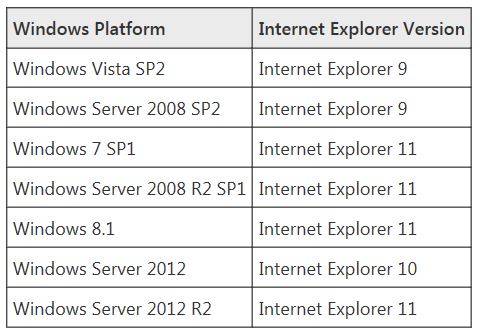News
Microsoft Support Ending in 2016 for IE, .NET Framework and SQL Server Versions
The year 2016 will see the end of "extended support" for some Microsoft products.
Losing extended support this month will be some older Internet Explorer browser versions, as well as some .NET Framework 4 versions. In April of this year, SQL Server 2005 also will lose extended support.
The loss of extended support means that Microsoft will stop issuing security patches for these products, which represents a potential security risk for organizations. The products won't get any future hotfixes, although there's an exception for software covered under Microsoft's "custom support" contracts. That's a potentially costly option, though, with costs going up after the first year.
Microsoft's enterprise software lifecycle product support is a policy with two five-year support phases, namely "mainstream support" and "extended support." At the end of those 10 years, Microsoft essentially considers its software to be "unsupported" and no longer developed.
IE Deadline
The Internet Explorer loss of extended support happens on Jan. 12, 2016. That's an accelerated deadline. Previously, IE browsers had product support lifecycles that were tied to the underlying Windows product lifecycles. With Microsoft's revised policy announced more than a year ago, organizations must upgrade to the most current IE version per supported Windows version by the Jan. 12, 2016 deadline.
In essence, the new IE policy means most organizations will need to be running IE 11 by the Jan. 12 deadline. However, there's an exception for the few organizations running Windows Vista Service Pack 2, which can continue to run the IE 9 browser since it's the most current IE browser for that Windows product. Here's a table illustrating this concept:
 Latest IE browsers per supported Windows. Source: Microsoft IE blog.
Latest IE browsers per supported Windows. Source: Microsoft IE blog.
Organizations particularly may have migration problems because of a need to support custom Web apps. They can try Microsoft's recently updated Enterprise Mode for Internet Explorer tools, which provides a means of emulating older IE technologies using an IE 11 browser. Alternatively, there's more granular support for browser compatibilities issues in the solutions offered by Browsium Inc.
IE 11 is currently the most used Internet Explorer version, according to general December Web polling by Net Applications. Those results showed IE 11 use at 25.6 percent, followed by IE 10 use at 4 percent and IE 9 use at 6.7 percent. IE 8 is still used by 9 percent, according to those stats.
.NET Framework 4 Deadline
Microsoft has also specified a Jan. 12, 2016 end of extended support deadline for some .NET Framework 4 versions. After that date, .NET Framework 4, 4.5 and 4.5.1 will cease getting hotfixes and security updates.
This deadline, part of a new policy announced in August 2014, may be easier to meet since organizations can install .NET Framework 4.5.2 or higher versions and continue to stay supported. The .NET versions from 4.5.2 are described by Microsoft as "in-place" upgrades, which make the process a bit easier. An in-place upgrade doesn't require that the earlier .NET Framework version be uninstalled.
Microsoft carved out an exception for .NET Framework 3.5 Service Pack 1. Its lifecycle is still based on Microsoft's old policy. That is, the product lifecycle of .NET Framework 3.5 Service Pack 1 is still based the underlying Windows product lifecycle and will lose extended support at the same time that Windows does.
SQL Server 2005 Deadline
The end of extended support for SQL Server 2005 is scheduled for April 12, 2016. It takes several months to plan and execute a SQL Server migration, according to Microsoft.
Microsoft's technical upgrade guide (PDF) suggests that it's possible to perform an in-place upgrade from SQL Server 2005 to SQL Server 2014. The exception is a move from 32-bit SQL Server 2005 to 64-bit SQL Server 2014, where an in-place upgrade can't be performed.
About the Author
Kurt Mackie is senior news producer for 1105 Media's Converge360 group.